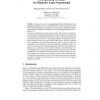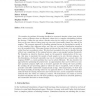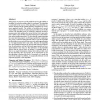889 search results - page 158 / 178 » Observational Learning in Random Networks |
AICOM
2006
13 years 7 months ago
2006
In this work we present a backjumping technique for Disjunctive Logic Programming (DLP) under the Answer Set Semantics. It builds upon related techniques that had originally been p...
JMLR
2008
13 years 7 months ago
2008
We consider the problem of learning classifiers in structured domains, where some objects have a subset of features that are inherently absent due to complex relationships between...
POPL
2007
ACM
14 years 8 months ago
2007
ACM
In this paper, we propose a new algorithm for proving the validity or invalidity of a pre/postcondition pair for a program. The algorithm is motivated by the success of the algori...
GECCO
2009
Springer
14 years 12 days ago
2009
Springer
HyperNEAT, a generative encoding for evolving artificial neural networks (ANNs), has the unique and powerful ability to exploit the geometry of a problem (e.g., symmetries) by enc...
ESA
2005
Springer
14 years 1 months ago
2005
Springer
Milgram’s experiment (1967) demonstrated that there are short chains of acquaintances between individuals, and that these chains can be discovered in a greedy manner. Kleinberg ...



